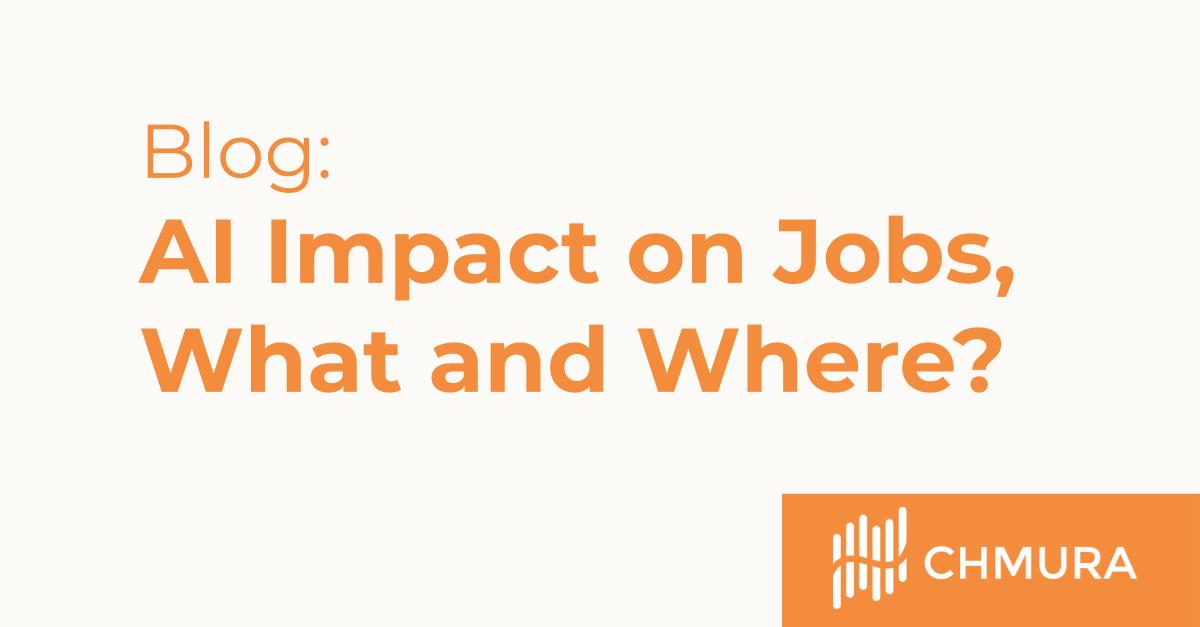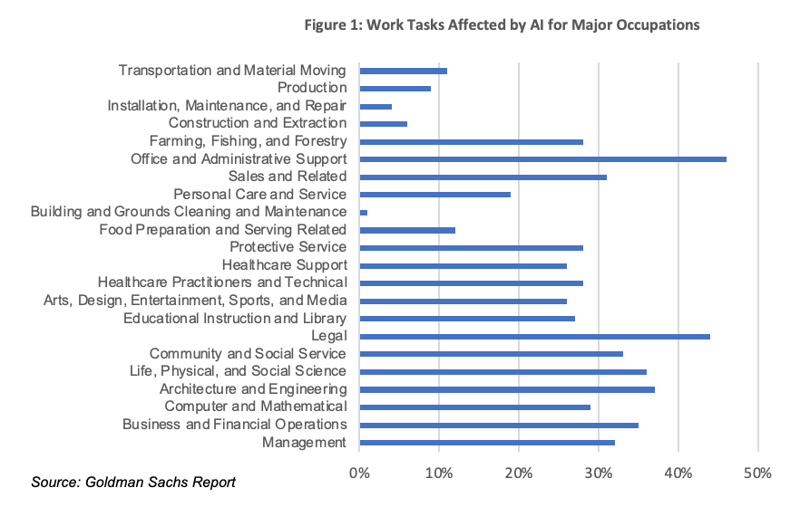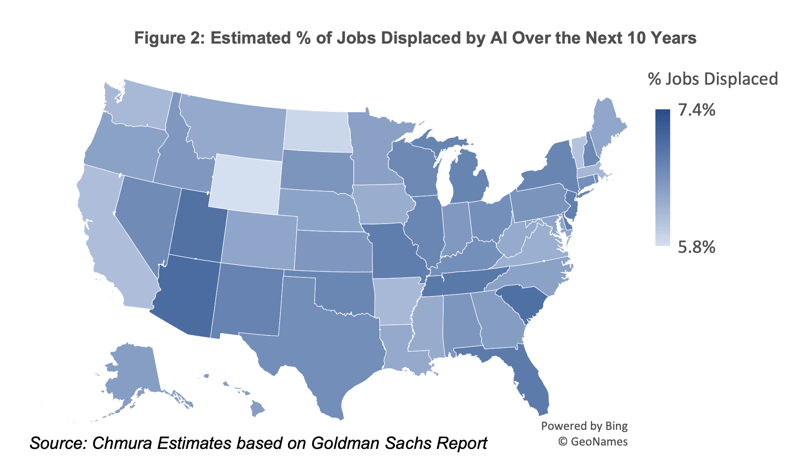AI Impact on Jobs, What and Where?

By Xiaobing Shuai and Alli Salata |
The explosion of artificial intelligence (AI) technology in the first half of 2023 has shaken not only the technology industry, but other parts of society. Experts and academics are grappling with the implications of this new technology on national security, research and development, business operations, commerce and entertainment, and our general way of life. Similarly, this technology has the potential to change the labor market significantly. This blog summarizes current research in this area and discusses how AI is used in Chmura’s JobsEQ.
What is AI and ChatGPT?
AI is a broad term that has been in existence for many years, and it refers to any technology that can simulate human intelligence. The recent development focuses on the area of generative artificial intelligence, or GPT models. GPT stands for Generative Pre-trained Transformer. This is essentially a large language model with algorithm that mimics the human language skills.[1]
The most prominent example of a GPT model is ChatGPT tool released by the firm OpenAI. OpenAI’s model has been incorporated into the Microsoft Bing search engine. Microsoft is also working to integrate AI with other tools such as the Microsoft Office software system.[2] Google released its own GPT-like tool, named BARD, and incorporated it with the popular Google Search Engine.[3]
Due to its strong capabilities in imitating human language, GPT tools have been adapted to perform different language-related tasks. There are anecdotal reports of utilizing GPT tools to complete research papers, write legal memos, and take exams.[4] There are also other AI tools being developed in association with a GPT model, which extends AI capabilities to areas beyond written language. For example, OpenAI has developed other AI tools, such as DALL-E, a tool that can generate and edit images based on language input; and Codex, a model that can translate natural language into computer code.[5] Other companies are leveraging OpenAI’s ChatGPT and developing specific tools tailored to very specific tasks.[6]
What Jobs are Affected?
As soon as the ChaptGPT model was released in late 2022, there were discussions on its effect on different jobs. In various reports, industry experts identified jobs that can be impacted by GPT technology. For example, customer service can use GPT models to provide improved customer experience. Researchers can use this model to generate more direct, human-like answers. Legal professions can use it to research cases and write summaries. Finally, developers can use it to write software code.[7] While those jobs can be improved by AI tools, other reports estimated that jobs such as bank tellers, postal service clerks, cashiers, data entry workers, and administrative assistants have a high likelihood of being replaced in the future.[8]
A recent study by Goldman Sachs systematically investigated how each occupation can be impacted by GPT and related AI technology.[9] Using O*Net data on about 900 occupations in the United States,[10] this study evaluated the work tasks associated with each occupation, and to what degree those tasks can be exposed to AI automation. They concluded that on average, 25% of work tasks in the United States can be automated with AI if AI technology matures in the next few years. Based on the major occupational groups, the top 5 occupations with the largest percentage of tasks to be potentially automated are: [11]
1. Office and Administrative Support (46%)
2. Legal (44%)
3. Architecture and Engineering (37%)
4. Life, Physical, and Social Science (36%)
5. Business and Financial Operations (35%)
Many of those top occupations impacted by AI are professional and business types of jobs, while physically intensive and outdoor occupations, such as construction, transportation, and production, are less exposed by the current wave of GPT AI technology (Figure 1).

Based on the number of tasks affected, the GS report assigned an exposure percentage for each occupation. If over 50% of the work tasks of an occupation are exposed by AI, this occupation is classified as potentially being replaced by AI. An exposure percentage of 0-10% indicates that this occupation is not impacted by AI. For the remaining occupations (with an exposure percentage of 10-50%), AI has the potential to complement such occupations and increase efficiency. The study concluded when AI technology matures and is widely deployed, that 7% of current U.S. employment could be replaced by AI, while 30% of jobs will not be impacted.

Using data from the GS report, Chmura estimated the percentage of employment in each state that could be displaced by AI. Not surprisingly, the District of Columbia has the highest exposure, due to the large number of government agencies, law firms, and government contractors based in the city. Other states such as South Carolina, Tennessee, and Utah, due to a relative higher concentration of jobs in office and administration support occupations. Wyoming and North Dakota are the states with the lowest percentage of jobs being displaced by AI. Those are states with a high concentration of mining and associated jobs.
New Job Opportunities?
Each wave of technological breakthroughs will displace certain jobs, but it also has the potential to generate new occupations that do not exist today. It is expected that the current set of AI tools can increase demand for some jobs and create many new occupations.
The technology sector will experience the immediate impact as companies race to develop and release new AI tools to the marketplace. A projection in World Economic Forum shows that in the next five years, from 2023 to 2027, AI and machine learning specialists will be the fastest growing jobs in the world.[12]
A wide range of businesses, even those not in the technology sector, will need jobs dealing with AI technology. One example is chief AI officer, a C-suite position in charge of technological decisions related to AI in a company. Other jobs such as prompt engineers, AI trainers, AI auditors, AI ethicists, and machine managers are emerging careers expected to grow in popularity and demand as more companies adopt AI technology.[13] While many new jobs are created to harness the benefits of AI technology, jobs are also needed to monitor and moderate any negative impact. For instance, the current version of GPT models may generate biased information or misinformation.[14] As a result, AI auditors or fact checkers are important for businesses using this technology.
Other Workforce Impacts?
AI technology has the potential to transform different aspects of future work. As the Goldman Sachs report shows, AI is predicted to replace only a small portion of existing jobs. For the majority of jobs, AI can augment those job functions and improve labor productivity. The report estimates if AI technology is deployed over a 10-year period, it can boost the overall productivity growth by 1.5 basis points per year. Assuming current productivity growth is 1.5% per year, deployment of AI could boost it to a 3.0% growth rate per year for 10 years.[15]
For certain industries, the potential for productivity gains can be even larger, especially for those industries with high exposures to AI. For example, in a case study for customer service representatives, having AI technology can improve productivity by 14%. [16]
AI can reshape workplace culture as well. AI can help realize the full potential of remote work, as hybrid work arrangements are becoming popular. Benefits could include effective information sharing, and collaboration. Similarly, management can also use AI tools to monitor work and identify behavior problems and patterns to improve efficiency.[17]
JobsEQ and AI?
Large language models have enormous potential for data analysis, especially in the area of unstructured text analysis such as the Real Time Intelligence job postings data in Chmura’s JobsEQ platform. The LLM’s are well equipped to assist in the transformation of natural language into structured datasets that Chmura is well known for providing. Chmura is exploring the use of AI in our data processing, while maintaining or improving our Quality Assurance targets.
In addition, the customer service aspects of GPT AI described above can also bring short-term rewards to SaaS products such as JobsEQ through an improved user experience. The JobsEQ Chat Team is accustomed to receiving high marks from our clients for their quality of service as well as fast response times—responding to the average chat in the less than a minute. That “live” Chat Team will not be going away. Nevertheless, as a supplemental service, Chmura’s engineers have embarked on the process of integrating ChatGPT into JobsEQ’s search capabilities, allowing users to ask questions in natural language and receive relevant, helpful responses, a technique known as semantic search. While natural language processing and semantic search are by no means new, GPT AI models are making these capabilities more accessible to software companies like Chmura.
--------------------------------------------
[1] Aatish Bhatia “Watch an A.I. Learn to Write by Reading Nothing but Shakespeare”. The New York Times, April 27, 2023.
[2] Jared Spataro. "Introducing Microsoft 365 Copilot – Your Copilot for Work." The Official Microsoft Blog, March 16, 2023. https://blogs.microsoft.com/blog/2023/03/16/introducing-microsoft-365-copilot-your-copilot-for-work/.
[3] Matt G. Southern "Google Launches Bard AI Chatbot To Compete With ChatGPT." Search Engine Journal. March 21, 2023. https://www.searchenginejournal.com/google-launches-bard-ai-chatbot-to-compete-with-chatgpt/482779/
[4] Debby R. Cotton, Peter A. Cotton, and J. R. Shipway. "Chatting and cheating: Ensuring academic integrity in the era of ChatGPT." Innovations in Education and Teaching International, 2023, 1-12. doi:10.1080/14703297.2023.2190148.
[5] https://platform.openai.com/docs/models/overview
[6] Jasper vs. Copy.ai: Which AI writing tool is better? [2023] | Zapier
[7] What Are Large Language Models and Why Are They Important? | NVIDIA Blog
[8] World Economic Forum “Future of Jobs Report, 2023”, https://www3.weforum.org/docs/WEF_Future_of_Jobs_2023.pdf
[9] Goldman Sachs, “The Potentially Large Effects of Artificial Intelligence on Economic Growth” March 2023, https://www.key4biz.it/wp-content/uploads/2023/03/Global-Economics-Analyst_-The-Potentially-Large-Effects-of-Artificial-Intelligence-on-Economic-Growth-Briggs_Kodnani.pdf
[10] O*Net has data related to occupations based on Standard Occupation Code (SOC).
[11] Major occupation group is defined as 2-digit standard occupational code in O-Net.
[12] World Economic Forum “Future of Jobs Report, 2023”, https://www3.weforum.org/docs/WEF_Future_of_Jobs_2023.pdf
[13] Eric Griffith, “You’re Hired: 5 New Jobs Created by AI”, https://www.pcmag.com/news/youre-hired-5-new-jobs-created-by-ai
[14] Tiffany Hsu and Stuart A. Thompson. "Disinformation Researchers Raise Alarms About A.I.Chatbots." The New York Times. Last modified February 13, 2023. https://www.nytimes.com/2023/02/08/technology/ai-chatbots-disinformation.html.
[15] Goldman Sachs, “The Potentially Large Effects of Artificial Intelligence on Economic Growth” March 2023, https://www.key4biz.it/wp-content/uploads/2023/03/Global-Economics-Analyst_-The-Potentially-Large-Effects-of-Artificial-Intelligence-on-Economic-Growth-Briggs_Kodnani.pdf
[16] Erik Brynjolfsson, Danielle Li, and Lindsey Raymond, “Generative AI at Work”, 2023, NBER Working Paper 311161, https://www.nber.org/papers/w31161
[17] Gleb Tsipursky “The AI Revolution Transforming Hybrid and Remote Work and the Return to Office” May 2023, Forbes https://www.forbes.com/sites/glebtsipursky/2023/05/09/the-ai-revolution-transforming-hybrid-and-remote-work-and-the-return-to-office/?sh=9b840c91493b
Subscribe to the Weekly Economic Update
Subscribe to the Weekly Economic Update and get news delivered straight to your inbox.











